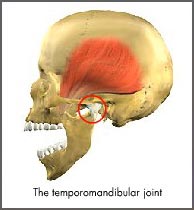TMD
by admin
Posted on December 16th, 2015 12:38 pm
The Temporomandibular joints are one of the most complex joints in our bodies. They are located on each side of our face, just in front of the ear, and are responsible for the rotating and gliding movements used in chewing and speaking. In combination with several muscles and ligaments, they make opening and closing our mouth possible.

Common symptoms of a TMJ disorder (TMD) include headache, earache, jaw pain, muscle soreness, limited opening, dizziness, clicking and popping noises when opening or closing the mouth, or even locking of the jaw. While these symptoms may be related to a sinus infection or a toothache, frequently they are associated with a TMJ disorder. It is important that you see your dentist so he can try to identify the source of the pain.
It is frequently difficult to determine a single cause of TMD. Symptoms may be caused from arthritis, injury, or the way your teeth fit together. Stress is also known to be a contributing factor.
TMJ treatment is very complex and varies greatly depending on individual circumstances. It is important to understand that TMJ therapy does not cure a TMJ disorder, but simply manages symptoms related to the problem. Damage to a joint is permanent. Therapy places the joints in a position where they experience the least trauma, minimizing future joint damage.
Often treatment involves an allied team of specialists, including orthodontists, physical therapists, pain management specialists, biofeedback specialists, and in extreme cases oral surgeons. Treatment may involve a combination of muscle relaxants, stress reducing exercises and wearing an appliance, called a splint. A splint places the joints in a position where the muscles, joints and teeth can work in harmony with each other. If splint therapy is successful, the need for further treatment can be determined. In most cases, “less is better”.
Occasionally very conservative treatment is not sufficient, and more aggressive treatments are required that might include combinations of orthodontics, prosthetics (crowns and bridges) or surgery. The goal of such treatment is to place the teeth or jaws in a position where symptoms can potentially be controlled. Often the best solution is long term splint therapy to slow joint deterioration and maintain an acceptable level of comfort.
